Introduction
This is a list of symbols we’ve seen used by Far-Right and Neo-Nazi groups involved in the Ukraine conflict, from both the Pro-Ukrainian and Pro-Russian side.
Please keep context in mind when analysing these symbols, while some symbols (such as the Black Sun) have an exclusively Neo-Nazi context, others have other meanings behind them, the best example is the Swastika, but this also includes other symbols such as the Chi-Rho and various Pagan Runes.
To judge if the use of one of these symbols indicates Far-Right or Neo-Nazi sympathies, look into the person/group’s background and worldviews, and check the descriptions we’ve written for these symbols to see if they might have a non-political/extremist context.
For a general list of Far-Right/Neo-Nazi symbols, including those unrelated to the Ukraine conflict, we recommend the ADL Hate Symbol database, which includes a wide variety of these symbols and details on the context behind them.
For more details on how to identify Far-Right/Neo-Nazi symbols, we recommend Michael Colborne’s “How (Not) To Interpret Far-Right Symbols”, published by Bellingcat.
Swastika

 Examples: Flag of the Nazi Party (top) and Nazi Germany (bottom)
Examples: Flag of the Nazi Party (top) and Nazi Germany (bottom)
Description/History:
A cultural and religious symbol used across the world (especially by religions like Buddhism, Jainism and Hinduism), originally used to represent values such as life, good luck or acting as a solar symbol, its usage going back tens of thousands of years.
It was later adopted by the Nazis in 1920 as a symbol of the Nazi Party, ideology and state, sometimes known in this context as the “Hakenkreuz” - Hooked Cross, a division exists today on its interpretation between Western and Eastern cultures, Western cultures often defining it by its Nazi use, with it being seen as socially unacceptable in most or all contexts and sometimes being legally banned from display, while many Eastern cultures define it by its older meaning, using it as a prominent religious or spiritual symbol:
According to René Guénon, the swastika represents the north pole, and the rotational movement around a centre or immutable axis (axis mundi), and only secondly it represents the Sun as a reflected function of the north pole. As such it is a symbol of life, of the vivifying role of the supreme principle of the universe, the absolute God, in relation to the cosmic order. It represents the activity (the Hellenic Logos, the Hindu Om, the Chinese Taiyi, ‘Great One’) of the principle of the universe in the formation of the world.
In their 1985 book Comet, Carl Sagan and Ann Druyan argue that the appearance of a rotating comet with a four-pronged tail as early as 2,000 years BCE could explain why the swastika is found in the cultures of both the Old World and the pre-Columbian Americas. The Han dynasty Book of Silk (2nd century BCE) depicts such a comet with a swastika-like symbol.
In Native American culture, particularly among the Pima people of Arizona, the swastika is a symbol of the four winds. Anthropologist Frank Hamilton Cushing noted that among the Pima the symbol of the four winds is made from a cross with the four curved arms (similar to a broken sun cross), and concludes “the right-angle swastika is primarily a representation of the circle of the four wind gods standing at the head of their trails, or directions.”
The swastika was widely used in Europe at the start of the 20th century. It symbolised many things to the Europeans, with the most common symbolism being of good luck and auspiciousness.20 In the wake of widespread popular usage, in post-World War I Germany, the newly established Nazi Party formally adopted the swastika in 1920.186187 The Nazi Party emblem was a black swastika rotated 45 degrees on a white circle on a red background. This insignia was used on the party’s flag, badge, and armband. Hitler also designed his personal standard using a black swastika sitting flat on one arm, not rotated.
- https://en.wikipedia.org/wiki/Swastika, https://en.wikipedia.org/wiki/Swastika#Association_with_Nazism
Examples of use:
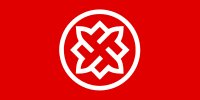 (Flag of Russian National Unity)
(Flag of Russian National Unity)
Reichsalder
 Example: German coat of arms during the Nazi era
Example: German coat of arms during the Nazi era
Description/History
The “Reich Eagle” or “Realm Eagle” is a former national emblem of Nazi Germany.
Variations of eagle designs have been used as state symbols by many governments over time (Weimar Germany, German Empire, Austria, Russia, and even modern Germany, now known as the “Bundesadler”) but this specific design was created by the Nazis, the right1 facing version acting as the Reichsadler, the symbol of the Nazi state, and a left facing version being used as the “Parteiadler”/“Party Eagle”, a symbol of the Nazi Party.
Examples of use:
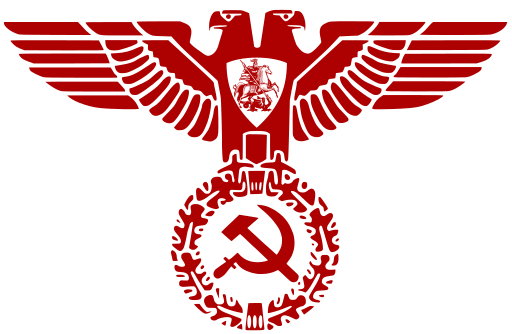 (Reichsalder modified to use the Soviet Hammer and Sickle and the Double-Headed form of the Imperial Russian eagle, used by the National Bolshevik Party)
(Reichsalder modified to use the Soviet Hammer and Sickle and the Double-Headed form of the Imperial Russian eagle, used by the National Bolshevik Party)
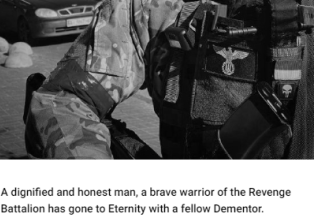 (Reichsadler modified to use the Ukrainian Trident emblem instead of the Swastika, used by a member of the Revanche Battalion)
(Reichsadler modified to use the Ukrainian Trident emblem instead of the Swastika, used by a member of the Revanche Battalion)
Pagan Runes
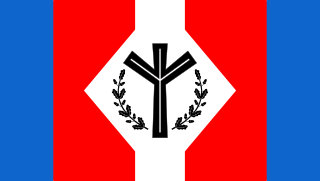
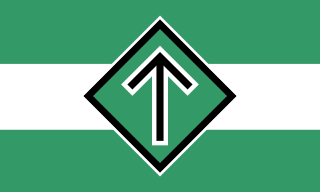 Examples: Algiz Rune used in the flag of the Neo Nazi “National Alliance” (top), Tyr Rune used in the flag of the Nordic Resistance Movement (bottom)
Examples: Algiz Rune used in the flag of the Neo Nazi “National Alliance” (top), Tyr Rune used in the flag of the Nordic Resistance Movement (bottom)
Description/History:
A series of ancient alphabets used by the Germanic peoples, later recreated and modified by various researchers and cultural influencers, various Runes of the alphabet were later adopted by the Nazi Party and Neo Nazi movements, most infamously the “lightning bolt” rune originally labelled as the Sowilō (Sun) rune, later adopted by the Nazis as the “Sigrune” (Sieg - Victory), other notable runes include the Tyr and Algiz runes:
The Man and Yr runes in Guido von List’s Armanen Futharkh were based on the Younger Futhark. List’s runes were later adopted and modified by Karl Maria Wiligut who was responsible for their adoptions in Nazi occultism. Both List and Wiligut have an “Yr” rune of the same shape as the Younger Futhark Yr rune.
In this context, the Man rune (identical in shape to the Elder Futhark Algiz) came to be understood in the Germanic mysticism of the early 20th century as symbolizing “life” and called the “life rune” (German: Lebensrune). This term occurs as early as the 1920s in the literature of Germanic mysticism,12 and it came to be widely used within the Nazi Party and Nazi Germany, e.g. in official prescriptions for the various uniforms of the Sturmabteilung.13
After 1945, the term “life rune” continued to be used as völkisch nationalism. Contemporary examples include use by the American National Alliance (as of 2007),15 and in reference to the Algiz rune in the logo of the Flemish nationalist Voorpost as levensrune (as of 2016).16
The Týr rune in Guido von List’s Armanen Futharkh was based on the version found in the Younger Futhark. List’s runes were later adopted and modified by Karl Maria Wiligut, who was responsible for their adoption by the Nazis, and they were subsequently widely used on insignia and literature during the Third Reich. It was the badge of the Sturmabteilung training schools, the Reichsführerschulen in Nazi Germany. In World War II, it was adopted as the unit insignia of the 32nd SS Volunteer Grenadier Division “30 Januar”.
In Neo-Nazism it has appeared, together with the Sowilo rune, in the emblem of the Kassel-based think tank Thule Seminar. It has also appeared as the former logo of the fashion label Thor Steinar, which was banned in Germany over resemblance to SS officer uniforms,12 and the Scandinavia-based Nordic Resistance Movement which uses the symbol onto a diamond with stripes (in the same shape as the Hitlerjugend flag) in green, white, and black. (It might also be noted that both these uses were technically incorrect, since both Thor and Thule would be spelled with a thurisaz, ᚦ, rune.) The symbol was one of the numerous Nazi/neo-Nazi and fascist symbols/slogans used by the perpetrator of the Christchurch mosque shootings Brenton Harrison Tarrant alongside the Black Sun, the Othala/Odal rune, the Celtic Cross, the Kolovrat swastika, the Fourteen Words, and the Archangel Michael’s Cross of the pro-Nazi Romanian organization Iron Guard.13
Examples of use:
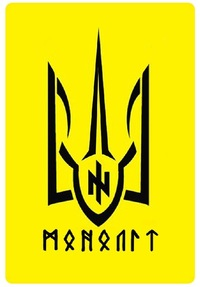 (Combination of various runes used in the logo of Monolith)
(Combination of various runes used in the logo of Monolith)
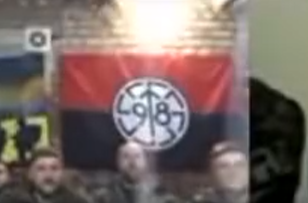 (Black Sun combined with the Tyr rune, a variant of the Black Sun and the OUN flag - Displayed by Azov-Dnipro)
(Black Sun combined with the Tyr rune, a variant of the Black Sun and the OUN flag - Displayed by Azov-Dnipro)
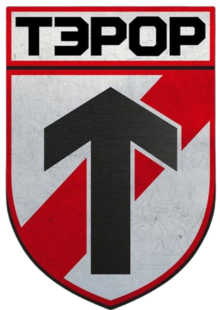 (Tyr rune logo used by the Terror Battalion)
(Tyr rune logo used by the Terror Battalion)
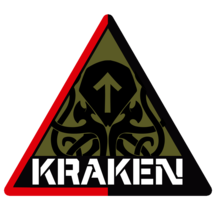 (Tyr rune and OUN flag colours on the logo of the Kraken Regiment)
(Tyr rune and OUN flag colours on the logo of the Kraken Regiment)
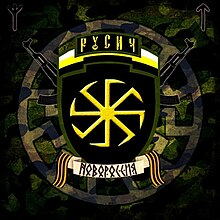 (Black Sun combined with the Kolovrat, Tyr Rune and Algiz Rune - Displayed by the Rusich Group)
(Black Sun combined with the Kolovrat, Tyr Rune and Algiz Rune - Displayed by the Rusich Group)
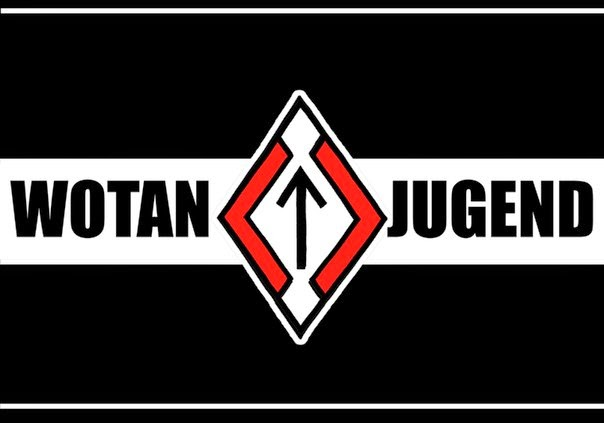 (Tyr rune used in the logo of Wotanjugend)
(Tyr rune used in the logo of Wotanjugend)
Black Sun
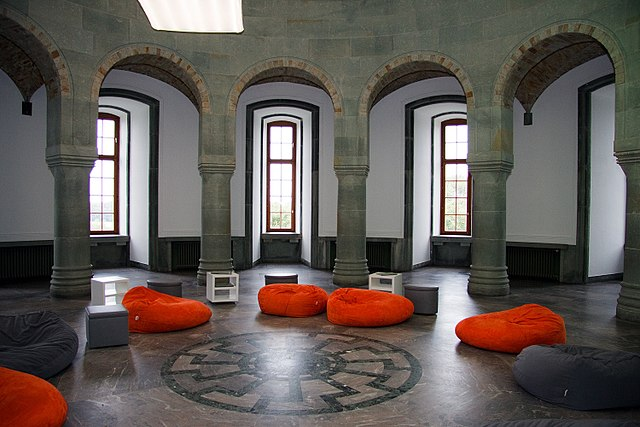 Example: “Black Sun” mosaic in Himmler’s castle
Example: “Black Sun” mosaic in Himmler’s castle
Description/History:
A runic symbol made up of 3 Swastikas, created through 12 “Sig” runes:
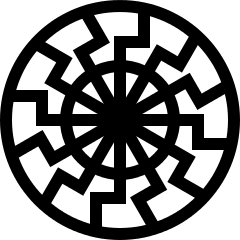
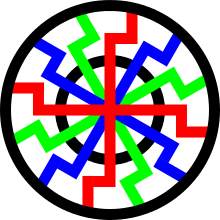 (Black Sun - left, Black Sun with Swastikas coloured - right)
(Black Sun - left, Black Sun with Swastikas coloured - right)
A symbol that first appeared as a mosaic in Wewelsburg Castle, a castle used as a central school, HQ and research centre by the SS, it originally had no name and isn’t believed to have had any particular meaning (most likely simply acting as a visual decoration), and the symbol in the castle itself is actually green.
The “Black Sun” is a cultural and alchemical term that was co-opted as a symbol of Neo-Nazi Occultism after being adopted by the “Landig Group” of ex-SS officer Wilhelm Landig (active between the 1950s and 1990s), the Black Sun at this time was still described and depicted with symbols different to the Wewelsburg mosaic.
The term and the mosaic were connected in a 1990s book called “The Black Sun of Thashi Lhumpo”, where the symbol is used to represent an occultic underground SS group called the “Agarthi”, this is the first time the Black Sun name was used with the symbol, and the book took off in popularity in the Neo-Nazi scene, causing the symbol to emerge as a replacement for the Swastika in many Neo Nazi circles as the Swastika itself had became too well known to display publicly. To fit with its name the Black Sun is usually depicted in a pure black colour (though sometimes other variations use colours like white, red or occassionally blue) and not its original green.
Though the name of the “Black Sun” is a stolen identity, the symbol itself originated with the Nazis, although inspired by older cultural inspirations it’s very much a product of Nazism.
The symbol that later became known as the “black sun” originated in the early 20th century, with the first depiction being the Wewelsburg mosaic. In 1933, Heinrich Himmler, the head of the SS, acquired Wewelsburg, a castle near Paderborn in the German region of Westphalia. Himmler intended to make the building into a center for the SS, and between 1936 and 1942, Himmler ordered the building expanded and rebuilt for ceremonial purposes.6 Himmler’s remodeling included the Wewelsburg mosaic that was composed of twelve dark-green radially overlaid sig runes, such as those employed in the logo of the SS, on the white marble floor of the structure’s north tower known as the “General’s Hall” (Obergruppenführersaal).note 1 The intended significance of the image remains unknown.
Some scholars have suggested that the artist may have found inspiration from motifs found on decorative Merovingian period discs (Zierscheiben) from Central Europe, which have been suggested to represent the sun, or its passing through the year.37note 2
The name “Black Sun” came into wider use after the publication of a 1991 occult thriller novel, Die Schwarze Sonne von Tashi Lhunpo (The Black Sun of Tashi Lhunpo), by the pseudonymous author Russell McCloud. The book links the Wewelsburg mosaic with the neo-Nazi concept of the “Black Sun”, invented by former SS officer Wilhelm Landig as a substitute for the Nazi swastika and a symbol for a mystic energy source that was supposed to renew the Aryan race.
Examples of use:
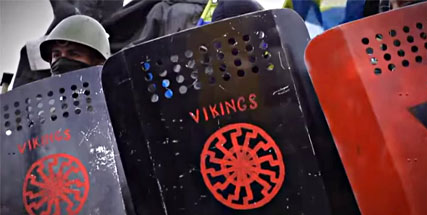 (“Viking” branded Black Sun shields displayed by Right Sector rioters)
(“Viking” branded Black Sun shields displayed by Right Sector rioters)
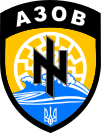 (Azov Battalion patch)
(Azov Battalion patch)
 (Logo of the “Black Sun” magazine - Formerly published by the Battalion)
(Logo of the “Black Sun” magazine - Formerly published by the Battalion)
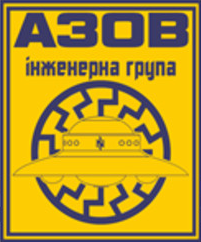 (Logo of the Azov Engineering Group, Black Sun combined with Wolfsangel)
(Logo of the Azov Engineering Group, Black Sun combined with Wolfsangel)
 (Black Sun combined with the Tyr rune and the OUN flag - Displayed by Azov-Dnipro)
(Black Sun combined with the Tyr rune and the OUN flag - Displayed by Azov-Dnipro)
 (Black Sun combined with the Kolovrat, Tyr Rune and Algiz Rune - Displayed by the Rusich Group)
(Black Sun combined with the Kolovrat, Tyr Rune and Algiz Rune - Displayed by the Rusich Group)
Kolovrat
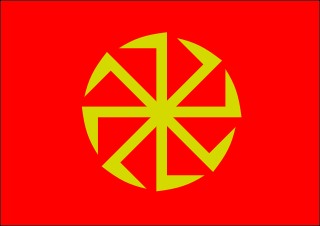 Example: Kolovrat flag designed by Neo-Nazi Alexey Dobrovolsky
Example: Kolovrat flag designed by Neo-Nazi Alexey Dobrovolsky
Description/History:
A Russian variant of the Black Sun adopted in the 1990s, made of 2 Swastikas, used for the same purpose as the Black Sun by various Neo Nazi groups:
In the early 1990s, the former dissident and one of the founders of Russian neo-paganism Alexey Dobrovolsky first gave the name “kolovrat” to a four-beam swastika, identical to the Nazi symbol, and later transferred this name to an eight-beam rectangular swastika.261 According to the historian and religious scholar Roman Shizhensky, Dobrovolsky took the idea of the swastika from the work “The Chronicle of Oera Linda”262 by the Nazi ideologist Herman Wirth, the first head of the Ahnenerbe.263
Aleksey Dobrovolsky introduced the eight-beam “kolovrat” as a symbol of “resurgent paganism.”264 He considered this version of the Kolovrat a pagan sign of the sun and, in 1996, declared it a symbol of the uncompromising “national liberation struggle” against the “Zhyd yoke”.265
According to Dobrovolsky, the meaning of the “kolovrat” completely coincides with the meaning of the Nazi swastika.266
Examples of use:
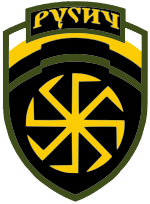 (Patch used by the Rusich Group)
(Patch used by the Rusich Group)
 (Black Sun combined with the Kolovrat, Tyr Rune and Algiz Rune - Displayed by the Rusich Group)
(Black Sun combined with the Kolovrat, Tyr Rune and Algiz Rune - Displayed by the Rusich Group)
Wolfsangel/“National Idea” symbol
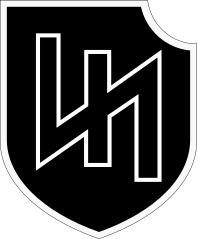
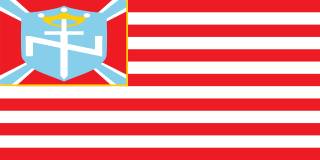 Example: Wolfsangel patch of 2nd SS Panzer Division Das Reich (top), Wolfsangel design used on the flag of the Neo-Nazi “Aryan Nations” organisation (bottom)
Example: Wolfsangel patch of 2nd SS Panzer Division Das Reich (top), Wolfsangel design used on the flag of the Neo-Nazi “Aryan Nations” organisation (bottom)
Description/History:
An ancient hunting tool later adopted as a heraldic symbol across Europe, later used by the Nazi Party and then adopted by Neo Nazi movements, including the “Social-Nationalist” movements in Ukraine:
The Wolfsangel was a European medieval wolf hunting tool whereby the hook was concealed inside a chunk of meat that would impale the unsuspecting wolf who would gulp the meat in one movement.
The term “Wolfs-Angel” (German) and “Hameçon” (French) appears in a 1714 German heraldic handbook titled Wappenkunst. However, the description is more specifically about the Wolfsanker (or Hameçon) component part of the Wolfsangel trap, and defines it as: “the shape of a crescent moon with a ring inside, at mid-height”, which describes the bar from which the Z-shaped hook is hung (see the yellow coat of arms of the von Stein family in the table opposite for an example).
In Nazi Germany, the Wolfsangel symbol was widely adopted in Nazi symbolism. It is not clear whether the driver of its adoption was Hitler’s strong personal association with wolf imagery (the Wolf’s Lair for example), or to create an association with the post-15th-century symbol of German independence and liberty, which had a particular relationship to the achievement of German freedom from foreign influence by force.
In Ukraine, far-right movements like the Social-National Party of Ukraine222324 and the Social-National Assembly,25 as well as the Azov Regiment of the Ukrainian army.26272829 have used a similar symbol of ꑭ (an elongated centre bar and the Z being rotated but untypically not reversed) for their political slogan Ідея Нації (Ukrainian for “National Idea”, where the symbol is a composite of the “N” and the “I”); they deny any connection or attempt to draw a parallel with the regiment and Nazism.30 Political scientist Andreas Umland told Deutsche Welle, that though it had far-right connotations, the Wolfsangel was not considered a fascist symbol by the general population in Ukraine.31 The Reporting Radicalism initiative from Freedom House notes that “Accidental use of this symbol or its use without an understanding of its connotations (for example as a talisman) is rare”, and ”… in Ukraine, the use of a Wolfsangel as a heraldic symbol or a traditional talisman would be uncharacteristic”.
Although the Social-Nationalists publicly refer to their Wolfsangel variant as the “National Idea” and reject any connections between this variant and the Wolfsangel, their denials lack credibility, as they often use the National Idea logo in conjunction with the Black Sun (an explicitly Neo Nazi symbol with no Pre-Nazi origins), and their “National Idea” variant looks very similar to other Wolfsangel designs, such as the Aryan Nations logo.
Examples of use:
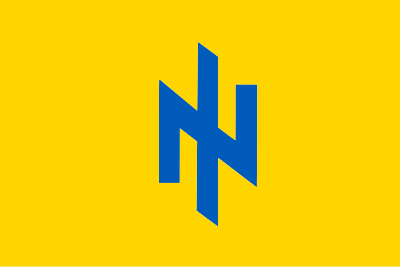 (Social-National Party flag)
(Social-National Party flag)
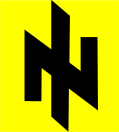 (Patriot of Ukraine and Social-National Assembly logo)
(Patriot of Ukraine and Social-National Assembly logo)
 (Monolith logo)
(Monolith logo)
 (Azov Battalion patch)
(Azov Battalion patch)
 (Azov Engineering Group logo)
(Azov Engineering Group logo)
 (Azov Brigade logo)
(Azov Brigade logo)
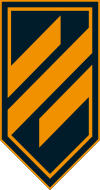 (3rd Separate Assault Brigade logo)
(3rd Separate Assault Brigade logo)
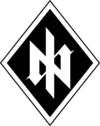
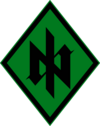
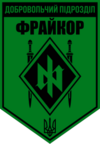
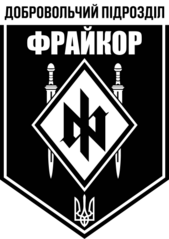 (Logos of the Freikorps Volunteer Unit and Freikorps Military-Patriotic Organisation)
(Logos of the Freikorps Volunteer Unit and Freikorps Military-Patriotic Organisation)
Chi-Rho
Description/History:
A Christian religious symbol with origins in the Roman Empire, originally used to represent the Resurrection of Jesus:
An early visual representation of the connection between the Crucifixion of Jesus and his resurrection, seen in the 4th century sarcophagus of Domitilla in Rome, the use of a wreath around the Chi-Rho symbolizes the victory of the Resurrection over death.
The symbol was later adopted by some far right participants of the Ukraine conflict, although the use of this symbol by far-right groups is quite rare.
Although the symbol is not commonly used in a far-right context, we’ve included it on this page to document far-right use of religious symbols (compare with for example, use of the Swastika or Pagan Runes) and the fact that far-right groups on both sides of the conflict use similar symbology (Brotherhood is a Pro-Ukrainian group while the Russian Imperial Legion is Pro-Russian).
Examples of use:
 (Logo of Brotherhood)
(Logo of Brotherhood)
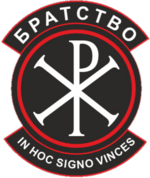 (Logo of the Brotherhood Battalion)
(Logo of the Brotherhood Battalion)
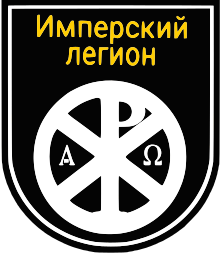 (Logo of the Russian Imperial Legion)
(Logo of the Russian Imperial Legion)
Identitarian Lambda Logo
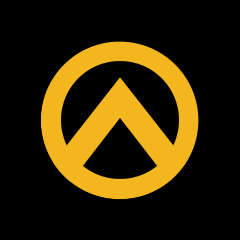 Example: Identarian Generation logo
Example: Identarian Generation logo
Description/History:
A stylised version of the letter “lambda” of the Greek alphabet, adopted by various European Ethno-Nationalists (who refer to themselves as “Identitarians”):
The Identitarian movement or Identitarianism is a pan-European, ethno-nationalist,345 far-right675 political ideology asserting the right of European ethnic groups and white peoples to Western culture and territories claimed to belong exclusively to them. Originating in France as Les Identitaires (“The Identitarians”), with its youth wing Generation Identity, the movement expanded to other European countries during the early 21st century.
Identitarians promote concepts such as pan-European nationalism, localism, ethnopluralism, remigration, or the Great Replacement, and they are generally opposed to globalisation, multiculturalism, Islamization and extra-European immigration.
Some Identitarians explicitly espouse ideas of xenophobia and racialism, but most limit their public statements to more docile language. Strongly opposed to cultural mixing, they promote the preservation of homogeneous ethno-cultural entities,124 generally to the exclusion of extra-European migrants and descendants of immigrants.131415 In 2019, the Identitarian Movement was classified by the German Federal Office for the Protection of the Constitution as right-wing extremist.
Lambda, the symbol of the Identitarian movement used primarily in Europe by Generation Identity and occasionally other countries, inspired by the Spartan shields in the movie 300 during the Battle of Thermopylae1
Examples of use:
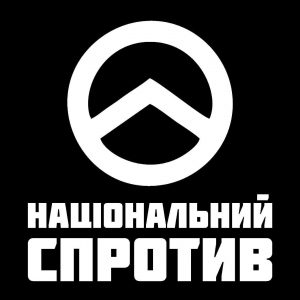
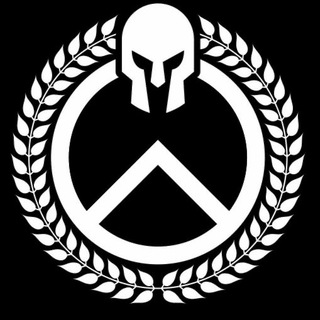 (Logos of the National Resistance)
(Logos of the National Resistance)
Valknut
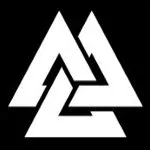
Description/History:
An ancient Germanic symbol appropriated by Neo-Nazis as a symbol of Aryanism and warrior spirit, similar to the co-opting of Pagan runes:
The Valknot or “knot of the slain” is an old Norse symbol that often represented the afterlife in carvings and designs. It is often considered a symbol of the Norse god Odin. Some white supremacists, particularly racist Odinists, have appropriated the Valknot to use as a racist symbol. Often they use it as a sign that they are willing to give their life to Odin, generally in battle.
Non-racist pagans may also use this symbol, so one should carefully examine it in context rather than assume that a particular use of the symbol is racist.
Examples of use:
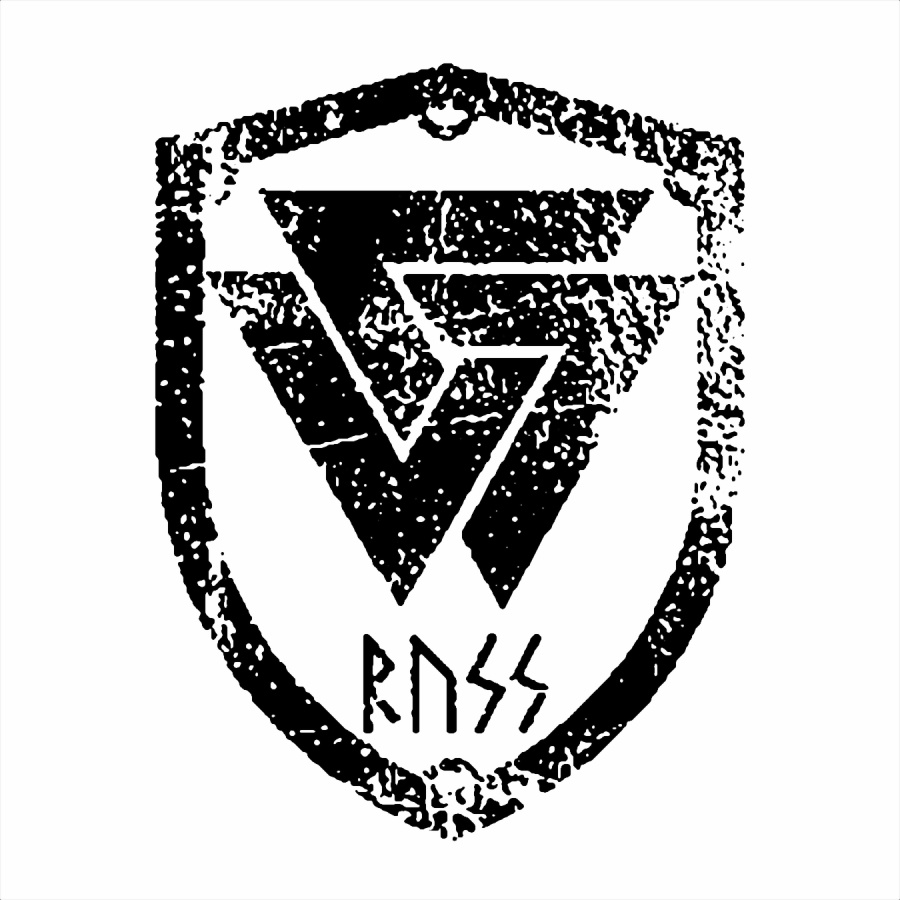 (Logo used by the Rusich Group Telegram - https://vk.com/dshrg2?z=photo-221221392_457239022)
(Logo used by the Rusich Group Telegram - https://vk.com/dshrg2?z=photo-221221392_457239022)
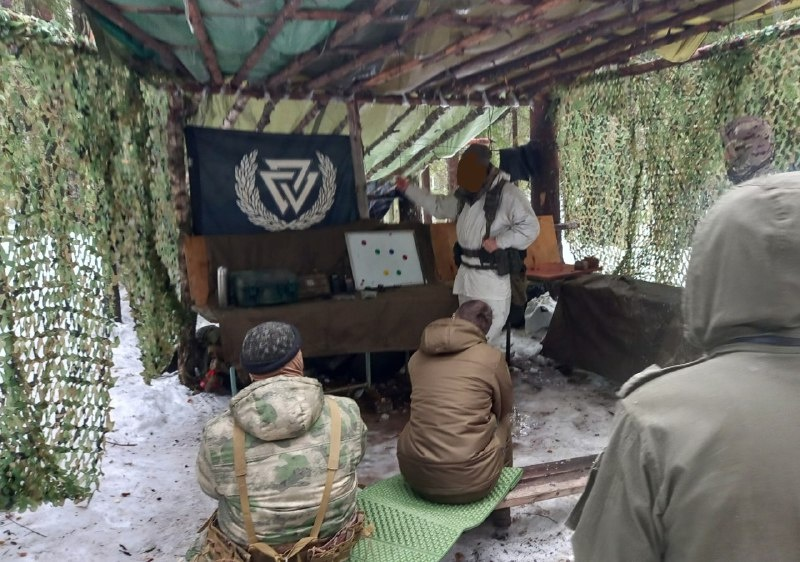 (Valknut flag displayed by Rusich Group - https://vk.com/albums-221221392?z=photo-221221392_457239319)
(Valknut flag displayed by Rusich Group - https://vk.com/albums-221221392?z=photo-221221392_457239319)
Nazi Collaborator Symbolism
OUN Symbolism
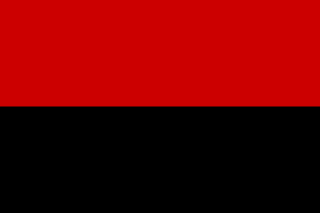
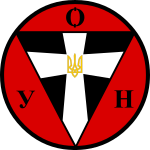 Example: Flag of the OUN-B (left) and emblem of the OUN-B (right)
Example: Flag of the OUN-B (left) and emblem of the OUN-B (right)
Description/History:
The Organisation of Ukrainian Nationalists - Bandera (OUN-B), was a wing of the Organisation of Ukrainian Nationalists (Організація українських націоналістів) - a far-right Ukrainian nationalist movement, led by Stepan Bandera.
The organisation supported the Nazi invasion of Ukraine and issued a declaration of Ukrainian independence after the takeover which declared loyalty to the Nazis:
The newly formed Ukrainian state will work closely with the National-Socialist Greater Germany, under the leadership of its leader Adolf Hitler which is forming a new order in Europe and the world and is helping the Ukrainian People to free itself from Moscovite occupation.
However, the Nazis were opposed to Ukrainian independence, launching a campaign against the OUN and detaining Bandera and the rest of the OUN leadership, they later reversed this attitude in March 1945, recognising Ukrainian independence under an OUN backed “Ukrainian National Committee”. According to Pavlo Shandruk, the head of the committee, Bandera offered “full support to the end” for the collaborator organisation, but it later dissolved after Nazi Germany capitulated 2 months later.
The Red and Black flag of the OUN-B was later adopted by various modern Ukrainian far-right groups.
It’s important to note that other political flags use the red/black colour scheme with no far-right connotations, for example Anarcho-Communists often use the same colours but with a diagonal line seperating them, as opposed to the OUN’s straight line.
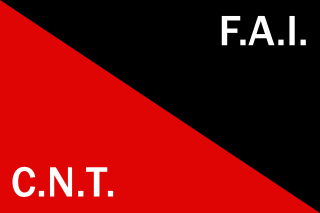
 (Example: Flag of the Anarcho-Communist CNT-FAI union on the left, Flag of the OUN-B on the right)
(Example: Flag of the Anarcho-Communist CNT-FAI union on the left, Flag of the OUN-B on the right)
Examples of use:
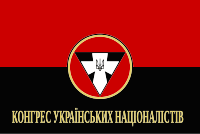 (OUN flag used by the Congress of Ukrainian Nationalists, with their name and a modified OUN seal added)
(OUN flag used by the Congress of Ukrainian Nationalists, with their name and a modified OUN seal added)
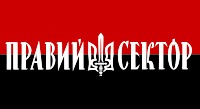 (OUN flag used by Right Sector, with their name and a variant of the Ukrainian coat of arms added)
(OUN flag used by Right Sector, with their name and a variant of the Ukrainian coat of arms added)
 (Black Sun combined with the Tyr rune, a variant of the Black Sun and the OUN flag - Displayed by Azov-Dnipro)
(Black Sun combined with the Tyr rune, a variant of the Black Sun and the OUN flag - Displayed by Azov-Dnipro)
 (Tyr rune and OUN flag colours on the logo of the Kraken Regiment)
(Tyr rune and OUN flag colours on the logo of the Kraken Regiment)
SS Galicia Symbolism
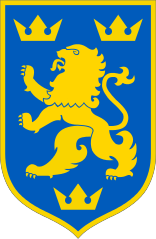 Example: Patch of the SS Galicia Division
Example: Patch of the SS Galicia Division
Description/History
The 14th Waffen Grenadier Division of the SS (1st Galician) (14а Гренадерська Дивізія СС (1а галицька)) was a Ukrainian Nazi collaborator unit formed after the Nazi occupation of Ukraine during the Eastern Front of World War 2, the division was later reorganised as a unit of the “Ukrainian National Army” in March 1945, a military force subordinated to the “Ukrainian National Committee” (see OUN Symbolism - Description/History), and disbanded 2 months later after the surrender of Nazi Germany.
The idea to organize a division of volunteers from Galicia was proposed by the German governor of District Galicia, Otto Wächter. He suggested creation of a Waffen-SS division composed of Galician volunteers and designed for regular combat on the Eastern Front. The creation of 14th Voluntary Division SS Galizien was announced in April 1943 at ceremonies throughout Galicia. At least 50 documents including contemporary newspaper clippings, radio broadcasts and speeches etc. record the date of 28 April. By June 1943 the first phase of recruitment had taken place. Initially Wächter’s proposal (which he was certain would be supported by Ukrainian circles) was rejected. In Berlin Wächter was able to get support from Heinrich Himmler who made the stipulation that the division would only made up of Galicians, who Himmler considered “more Aryan-like”.5 The terms “Ukrainian”, “Ukraine”, could not be used when addressing the division, stressing the Imperial Austro-Hungarian heritage of the term “Galizien”.6 David Marples suggests that the division was titled “Galicia” to avoid using the politically contentious term “Ukrainian,” while historian Samuel W. Mitcham Jr. claims the term was chosen at the insistence of Hitler, which irritated many of the Slavic recruits.”78
The 14th Waffen Grenadier Division of the SS (1st Galician) is today honored by many Ukrainian nationalists.59 Since 2010 every year on 28 April a march is held to celebrate the foundation of the division.60.
The symbolism of the division was later adopted by some far-right groups in modern Ukraine.
It’s important to note that the Galicia Division symbol can easily be confused with other non-far right symbols:
Due to the prevalence of lion symbols, it is important to take into account the context in which an SS Galizien symbol is used, and check for the presence of other far-right emblems and inscriptions. It is also important to verify that the given symbol corresponds directly with the image above, paying particular attention to whether or not crowns are included in the emblem
- https://reportingradicalism.org/en/hate-symbols/movements/nazi-symbols/ss-galizien
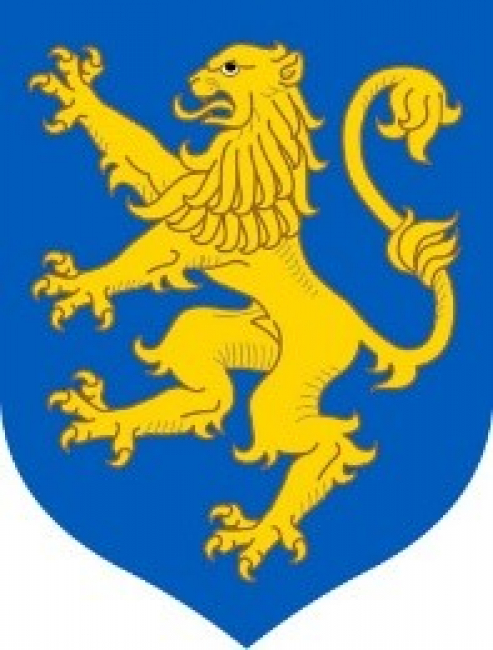 (Similar symbols that are not hate symbols - Coat of arms of the Kingdom of Galicia–Volhynia)
(Similar symbols that are not hate symbols - Coat of arms of the Kingdom of Galicia–Volhynia)
Examples of use
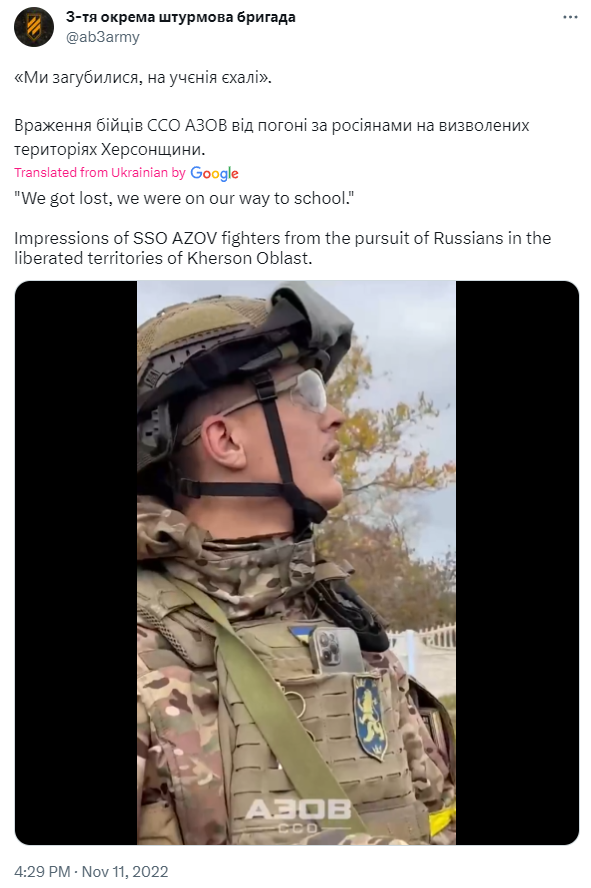 (Galicia Division patch worn by a soldier of the 3rd Separate Assault Brigade)
(Galicia Division patch worn by a soldier of the 3rd Separate Assault Brigade)
Russian Liberation Army Symbolism
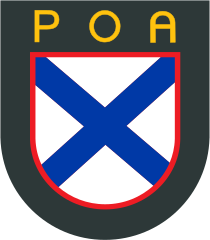 Example: Chevron of the Russian Liberation Army
Example: Chevron of the Russian Liberation Army
Description/History:
The Russian Liberation Army (Русская освободительная армия) was a Russian Nazi collaborator unit consisting of defecting Soviet Russian troops captured on the Eastern Front during World War 2, the unit later joined the Germany Army and fought for the Axis until the end of the war in Europe, its symbols have occasionally been adopted by Russian Neo Nazi groups in modern times.
The Russian Liberation Army (German: Russische Befreiungsarmee; Russian: Русская освободительная армия, Russkaya osvoboditel’naya armiya, abbreviated as РОА, ROA, also known as the Vlasov army (Власовская армия, Vlasovskaya armiya)) was a collaborationist formation, primarily composed of Russians, that fought under German command during World War II. The army was led by Andrey Vlasov, a Red Army general who had defected, and members of the army are often referred to as Vlasovtsy (Власовцы). In 1944, it became known as the Armed Forces of the Committee for the Liberation of the Peoples of Russia (Вооружённые силы Комитета освобождения народов России, Vooruzhonnyye sily Komiteta osvobozhdeniya narodov Rossii, abbreviated as ВС КОНР, VS KONR).
According to Reuters, the RVC uses the symbols of the Russian Liberation Army, which collaborated with Nazi Germany during World War II.
Examples of use:
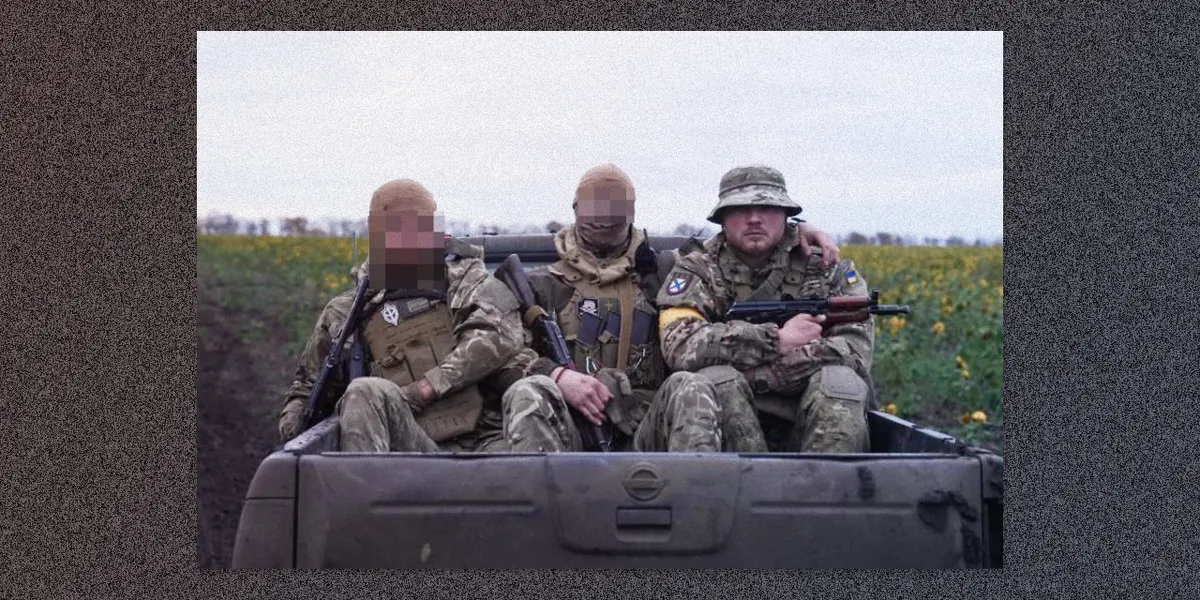 (POA patches displayed by the Russian Volunteer Corps)
(POA patches displayed by the Russian Volunteer Corps)
Footnotes
Return to 000. INDEX
Footnotes
-
Although from our perspective the Party Eagle has its head facing right and the Reich Eagle faces left, from the Eagle’s perspective it’s the other way around, and a Nazi document from the era describes it as Party facing left, Reich facing right ↩